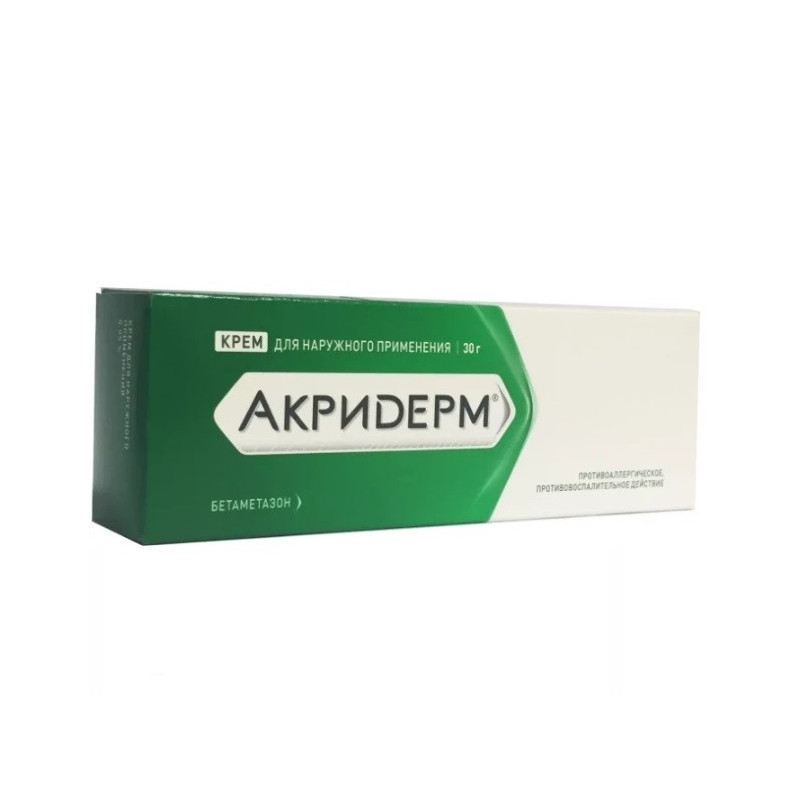



 All payments are encrypted via SSL
All payments are encrypted via SSL
 Full Refund if you haven't received your order
Full Refund if you haven't received your order
Pharmachologic effect.
Anti-inflammatory, glucocorticoid, antiallergic, antipruritic. When applied topically, it constricts blood vessels, relieves itching, reduces the release of inflammatory mediators, interleukins 1 and 2, gamma-interferon, inhibits the activity of hyaluronidase and lowers the permeability of the vascular wall. Interacts with specific receptors in the cytoplasm of the cell, stimulates the synthesis of mRNA, inducing the formation of proteins, including lipocortin mediating cellular effects. Increases blood glucose levels, accelerates protein catabolism, retains sodium and water. After parenteral and enteral administration, it is rapidly absorbed - the maximum effect (on ingestion) develops after 1-2 hours. In plasma, it binds to proteins. Easily passes histohematogenous barriers, including placental. Biotransformed in the liver (predominantly), the metabolites formed are not active. Excreted by the kidneys; partially excreted in breast milk.
Indications for use.
Congenital adrenal hypoplasia, adrenal insufficiency (usually in combination with mineralocorticoid); shock (anaphylactic, endotoxic, hemodynamic); thyroiditis (acute, chronic), thyrotoxic crisis, hypercalcemia due to malignant neoplasms; rheumatoid arthritis in the acute phase, acute rheumatic heart disease, systemic lupus erythematosus, scleroderma, etc.Systemic diseases of the connective tissue, inflammation of the joints and soft tissues, including periarticular (traumatic arthritis, acute gouty and other genesis, osteoarthritis, osteochondritis, bursitis, fibrositis, tendonitis, tendovaginitis, tendosinovitis, ankylosing spondylitis, myositis); prevention of graft rejection; nephrotic syndrome; severe allergic, incl. anaphylactoid reactions (caused by drugs associated with blood transfusion, allergic rhinitis, angioedema, serum sickness, etc.); bronchial asthma (including asthmatic status), sarcoidosis, berylliosis, Leffler syndrome, aspiration pneumonitis; cerebral edema (traumatic, postoperative, metastatic, post-stroke); neurodermatitis, dermatitis (simple, exfoliative, solar, seborrheic, radiation, bullous herpetiform, contact, atopic, lower extremities with circulatory failure, etc.), eczema (children, atopic, monetiform), psoriasis, diaper rash, nesting baldness, colloid scar Gaida pruritus, pruritus (senile, anogenital), erythema multiforme exudative, erythroderma, pemphigus, fungoid mycosis and other skin diseases; recurrent aphthous stomatitis; ulcerative colitis, Crohn's disease; anemia (autoimmune hemolytic, congenital hypoplastic), idiopathic and secondary thrombocytopenia in adults, acute leukemia in children, lymphomas (Hodgkin's,non-Hodgkin), lymphocytic leukemia (chronic); allergic conjunctivitis and corneal ulcer, keratitis, iridocyclitis, iritis, chorioretinitis, diffuse choroiditis, retrobulbar neuritis, prevention of distress syndrome in newborns, croup in diphtheria, tuberculous meningitis, tetanus (in combination with antimicrobial agents); breast cancer, prostate.
Contraindications.
Hypersensitivity, systemic mycoses, HIV infection, active forms of tuberculosis, chicken pox, herpes simplex, incl. eye, oral cavity, and other viral diseases, vaccination period, peptic ulcers of the gastrointestinal tract, gastric ulcer and duodenal ulcer (in the acute phase), diverticulitis, esophagitis, gastritis, fresh intestinal anastomoses, congestive heart failure, thrombophlebitis, arterial hypertension, diabetes, Itsenko – Cushing’s disease, osteoporosis, myasthenia gravis, hypoalbuminemia, severe impaired liver and kidney function, psychosis, open-angle glaucoma, pregnancy (including pre-eclampsia, eclampsia), breast-feeding (especially during high ozah drug); intra-articular, to the lesion: unstable joints, anterior arthroplasty, periarticular infection, infected lesions, impaired blood coagulation; outwardly: acne (pink, ordinary), primary viral, fungal, bacterial, incl. tuberculosis, infections of the skin and scalp; in children under 1 year old rash (against the background of diaper rash), dermatitis and dermatosis.
Side effect.
Hypokalemia, muscle weakness, myopathy, osteoporosis, spontaneous fractures, arterial hypertension, myocardial, arrhythmia, thrombosis and thromboembolism, erosive and ulcerative shock syndrome, steroid diabetes, lowered immunity and activation of infectious diseases, the suppression of the hypothalamic-pituitary-adrenal system, the appearance of hirsutism and acne, disturbed menstruation, Itsenko – Cushing’s syndrome, weight gain, sleep disturbance, euphoria, agitation or depression, anxiety, psychosis, glaucoma, cataract, steroid exophthalmos, withdrawal syndrome (with abrupt termination of long-term therapy); rarely, sodium and water retention (edema); local - itching, hyperemia, burning, dryness, pigmentation disturbance, dermatitis (perioral, allergic), maceration and atrophy of the skin, stria, prickly heat, secondary infections of the skin and mucous membranes.
Drug interaction.
Therapeutic, toxic effects reduce inductors liver enzymes increase - estrogens and oral contraceptives, the likelihood of arrhythmias and hypokalemia - glycosides digitalis, diuretics (causing potassium deficiency), amphotericin B, carbonic anhydrase inhibitors, the risk of ulcer-erosive lesions or hemorrhages in the stomach - alcohol and NSAIDs; the likelihood of infections and the development of lymphomas and other lymphoproliferative diseases are immunosuppressants, the possibility of pulmonary edema in pregnant women is ritodrin. Weakens the hypoglycemic activity of antidiabetic agents and insulin,natriuretic and diuretic - diuretic, vaccine activity (due to reduced antibody production); anticoagulant - derivatives of coumarin and indandione, Heparin, streptokinase and urokinase. Increases hepatotoxicity of Paracetamol. Reduces the concentration in the blood of salicylates, meksiletin.
Symptoms: nausea, vomiting, sleep disorders, euphoria, agitation, depression. With prolonged use in high doses - osteoporosis, fluid retention in the body, increased blood pressure and other signs of hypercorticism, including Itsenko – Cushing syndrome, secondary adrenal insufficiency.
Treatment: on the background of gradual withdrawal of the drug, maintenance of vital functions, correction of electrolyte balance, antacids, phenothiazines, lithium preparations; with Itsenko - Cushing syndrome - aminoglutetimid.
Special instructions.
It is used with caution in diabetes mellitus, corneal herpes, systemic lupus erythematosus (increased risk of aseptic necrosis), osteoporosis, in patients with a risk of thrombosis (prescribed with anticoagulants), in the elderly (increased risk of arterial hypertension, osteoporosis, especially in post-menopausal women) period), in children, only against the background of appropriate antibiotic therapy - with abscesses, purulent infections, tuberculosis. It is necessary to take into account the increased effect in hypothyroidism, liver cirrhosis, the likelihood of development (especially with long-term use) of relative adrenal insufficiency (within several months after discontinuation of the drug).With long-term treatment, it is necessary to carefully monitor the growth and development dynamics in children, periodically conduct an ophthalmologic examination (to detect glaucoma, cataracts, etc.), regularly monitor the function of the hypothalamic-pituitary-adrenal system, glucose levels in the blood and urine (especially in patients with sugar diabetes), electrolytes in serum, occult blood in feces. During therapy, avoid immunization, alcohol.
Terms and conditions of storage.
At a temperature of 15–25 ° C, 2 years
